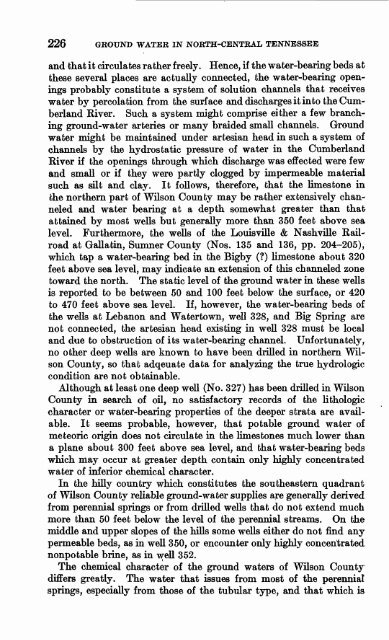GROUND WATER IN NORTH-CENTRAL TENNESSEE
GROUND WATER IN NORTH-CENTRAL TENNESSEE
GROUND WATER IN NORTH-CENTRAL TENNESSEE
You also want an ePaper? Increase the reach of your titles
YUMPU automatically turns print PDFs into web optimized ePapers that Google loves.
226 <strong>GROUND</strong> <strong>WATER</strong> <strong>IN</strong> <strong>NORTH</strong>-<strong>CENTRAL</strong> <strong>TENNESSEE</strong><br />
and that it circulates rather freely. Hence, if the water-bearing beds at<br />
these several places are actually connected, the water-bearing open<br />
ings probably constitute a system of solution channels that receives<br />
water by percolation from the surface and discharges it into the Cum<br />
berland Eiver. Such a system might comprise either a few branch<br />
ing ground-water arteries or many braided small channels. Ground<br />
water might be maintained under artesian head in such a system of<br />
channels by the hydrostatic pressure of water in the Cumberland<br />
Eiver if the openings through which discharge was effected were few<br />
and small or if they were partly clogged by impermeable material<br />
such as silt and clay. It follows, therefore, that the limestone in<br />
che northern part of Wilson County may be rather extensively chan<br />
neled and water bearing at a depth somewhat greater than that<br />
attained by most wells but generally more than 350 feet above sea<br />
level. Furthermore, the wells of the Louisville & Nashville Kail-<br />
road at Gallatin, Sumner County (Nos. 135 and 136, pp. 204-205),<br />
which tap a water-bearing bed in the Bigby (?) limestone about 320<br />
feet above sea level, may indicate an extension of this channeled zone<br />
toward the north. The static level of the ground water in these wells<br />
is reported to be between 50 and 100 feet below the surface, or 420<br />
to 470 feet above sea level. If, however, the water-bearing beds of<br />
the wells at Lebanon and Watertown, well 328, and Big Spring are<br />
not connected, the artesian head existing in well 328 must be local<br />
and due to obstruction of its water-bearing channel. Unfortunately,<br />
no other deep wells are known to have been drilled in northern Wil<br />
son County, so that adqeuate data for analyzing the true hydrologic<br />
condition are not obtainable.<br />
Although at least one deep well (No. 327) has been drilled in Wilson<br />
County in search of oil, no satisfactory records of the lithologic<br />
character or water-bearing properties of the deeper strata are avail<br />
able. It seems probable, however, that potable ground water of<br />
meteoric origin does not circulate in the limestones much lower than<br />
a plane about 300 feet above sea level, and that water-bearing beds<br />
which may occur at greater depth contain only highly concentrated<br />
water of inferior chemical character.<br />
In the hilly country which constitutes the southeastern quadrant<br />
of Wilson County reliable ground-water supplies are generally derived<br />
from perennial springs or from drilled wells that do not extend much<br />
more than 50 feet below the level of the perennial streams. On the<br />
middle and upper slopes of the hills some wells either do not find any<br />
permeable beds, as in well 350, or encounter only highly concentrated<br />
nonpo table brine, as in well 352.<br />
The chemical character of the ground waters of Wilson County<br />
differs greatly. The water that issues from most of the perennial<br />
springs, especially from those of the tubular type, and that which is

















